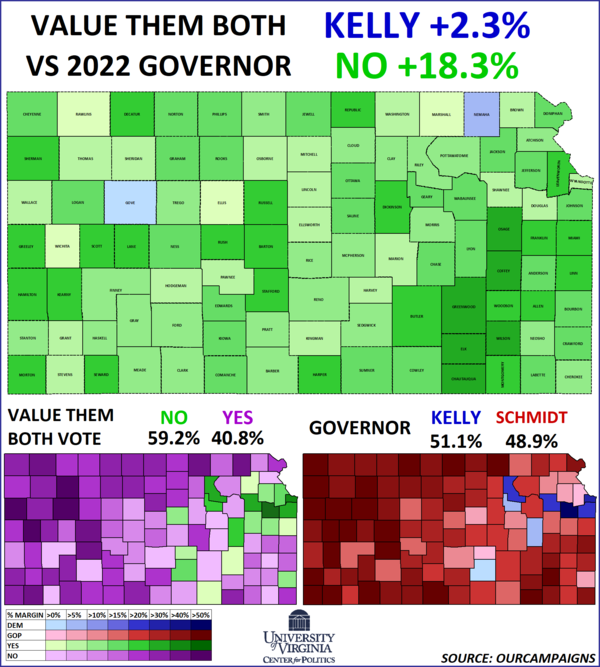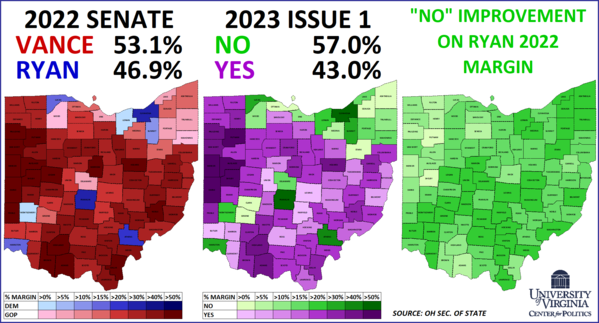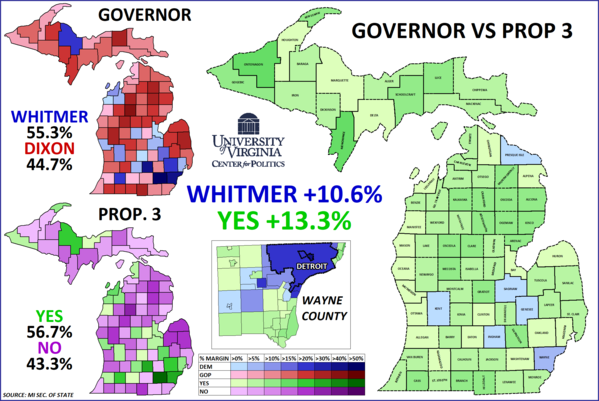The Atlas of Post-Dobbs Abortion Ballot Measures: Part One
A Commentary By J. Miles Coleman
Comparing ballot issues to partisan races in KS, OH, and MI.
KEY POINTS FROM THIS ARTICLE
— Since the Supreme Court’s Dobbs decisions last year, seven states have held abortion-related ballot issues, and abortion rights advocates have won all seven contests.
— In Kansas and Michigan, the pro-abortion rights side broadly outperformed the winning Democratic nominees for governor.
— In Ohio, last week’s Issue 1 ballot question, which was cast as a proxy vote on abortion rights, followed a similar pattern, roundly outperforming now-former Rep. Tim Ryan’s (D) showing in last year’s Senate race.
Abortion ballot issues vs partisan races
Whenever we cover a major ballot issue at the Crystal Ball, we always caution that, even though some votes are framed through heavily nationalized lenses, not everything from these votes can be transferred to typical partisan races. That said, since the U.S. Supreme Court’s Dobbs ruling last year, seven states have held ballot measures that relate, whether directly or indirectly, to abortion rights. Abortion rights advocates have come out on the winning side of all seven contests, which is something that has been widely interpreted as a promising trend for Democrats — so the urge to compare ballot issues to partisan races is strong.
With that, we’ll be going through all seven states and seeing how the pro-abortion rights side of those ballot issues compares to the performances of Democrats in some recent key races. Aside from the obvious caveats, it’s important to note that each ballot issue — wording, timing, etc. — was unique. We’ll start with Kansas, Michigan, and Ohio this week, and tackle some other states in Part Two.
Kansas
The first abortion-related statewide ballot issue of the post-Dobbs era came not long after the Supreme Court handed down its ruling in the case. In early August, voters in Kansas shot down a constitutional amendment dubbed “Value Them Both” — if passed, it would have added language to the state constitution specifying that the state does not guarantee a right to abortion.
The Value Them Both Amendment failed by a nearly 60%-40% margin, which was seen as a crucial early win for abortion rights advocates. Just a few months later, Gov. Laura Kelly (D) was reelected to a second term, beating state Attorney General Derek Schmidt (R) by a little more than 2 points. Map 1 compares the two elections.
Map 1: Kansas 2022 governor vs Value Them Both vote
Note: Maps 1, 2, and 3 use the two-party vote for, respectively, the 2022 Kansas gubernatorial race, the 2022 Ohio Senate race, and the 2022 Michigan gubernatorial race. Click on the maps to see larger versions of them.
Kelly and “No” obviously ran well in the same places. Douglas County (Lawrence, home to the University of Kansas) was the best county for both, and each carried populous Johnson County (Kansas City suburbs) by more than 20 points. Neither carried many counties west of Manhattan’s Riley County (home to Kansas State University and the westernmost dark blue county on the gubernatorial map).
Still, looking county by county, there didn’t seem to be an obvious pattern as to where No outperformed Kelly, although the returns offer a few takeaways. Considering it won by a much larger margin, it isn’t too surprising that No performed better in 103 out of the state’s 105 counties: the only exceptions were sparsely-populated Gove County, in the far west, and Nemaha County, which borders Nebraska in the northeast.
As the large image on Map 1 shows, No outperformed Kelly by more than 30 points in 6 counties, all in the eastern part of the state. These six counties roughly line up with the Chautauqua Hills region of the state. In the general election, these counties also saw some of the biggest swings against Kelly from her 2018 victory, so it was perhaps an area where she broadly ran behind expectations.
Aside from the aforementioned Douglas County, Kelly ran relatively close to the No margin in Wyandotte (which contains part of Kansas City proper) and Shawnee (Topeka) counties. Kelly, as the sole statewide Democrat to win in Kansas, probably maxed out the Democratic vote share in those types of localities, which got her close to matching No’s showing. Aside from Gove and Nemaha, Kelly came closest to matching No’s margin in Ellis County, right in the middle of western Kansas. Though also sparsely populated, Ellis County is known for having a large Catholic population (in 1960, along with still-heavily Democratic Wyandotte, it was one of the two Kansas counties that John F. Kennedy carried).
Ohio
Last week, we covered Ohio’s vote on the Issue 1 ballot question. If passed, Issue 1 would have raised the threshold for constitutional amendments to be put on the ballot and, ultimately, approved. On paper, the Issue 1 vote was not directly related to abortion rights. But had Issue 1 passed, it would have raised the approval threshold to 60% of the popular vote ahead of an abortion rights constitutional amendment vote that will take place later this fall — the higher threshold would have also presented a hurdle for voting rights advocates who are looking to reform the state’s redistricting process (that may appear on the ballot next year).
In our post-mortem map from last week, we compared the 57%-43% victory for No to Sen. Sherrod Brown’s (D) 53%-47% reelection in 2018. Our thinking there was that, since Brown is up next year — and his race will almost certainly be the marquee contest in the state — it was worth looking back at his win. But for today, we’ll use something more recent for our map. In 2022, Ohio saw another competitive (perhaps more so than it should have been) Senate race, where now-Sen. J. D. Vance (R) prevailed over longtime Youngstown Rep. Tim Ryan (D). Vance, a Republican, won by roughly the same margin as Brown, a Democrat, did four years earlier. Map 2 compares the 2022 Senate race and 2023 Issue 1 vote.
Map 2: 2022 Ohio Senate race vs 2023 Issue 1
Unlike Brown, who outpaced No in about half of the state’s 88 counties, Ryan underperformed No in every county. Ryan came within a point of matching No in Putnam County, his best relative showing, in the heavily German northwestern part of the state (Putnam, like Ellis in Kansas, also has a large Catholic population). Ryan’s second-best relative result came in nearby Shelby County. Since the New Deal era, both Putnam and Shelby have been among the most conservative counties in the state — they were among the best counties in the state for both Vance and the Yes vote.
The large image on Map 2 underscores that, while Issue 1 failed by a decisive margin overall, a key factor in No’s success was overperformance in the suburban and exurban counties. Let’s consider the large counties that contain the state’s “Three Cs”: Cleveland’s Cuyahoga, Columbus’s Franklin, and Cincinnati’s Hamilton. In each of those large counties, No ran 17% to 18% ahead of Ryan’s margins from 2022 — impressive, but that is less than the statewide swing of 20%. With the exception of Akron’s Summit, No ran more than 20 points ahead of Ryan in every county that borders one of the “Three Cs” counties.
One other facet of No’s strength was its overperformance in parts of Appalachia. Though turnout was relatively low compared to the state in that region last week, Jackson, Lawrence, and Belmont counties all swung more than 25 points in No’s direction, while some Appalachian-area counties also saw notable movement. It’s possible that some of the many Obama-to-Trump voters in that area will vote for populist-y candidates (like Vance) as well as more standard-issue Republicans but are not yet totally on board with all of the GOP’s policy positions. Alternatively, Democrats, even in the rural areas, may have just been more motivated to turn out for the Issue 1 vote than Republicans were.
Michigan
One state north of Ohio, Michigan had one of 2022’s most visible abortion votes. After the Dobbs decision, the state was set to revert to a strict 1931 law that would have banned abortion in all cases except to save the mother’s life. Though the status of that law ended up in legal limbo, the state Supreme Court allowed what became known as Proposal 3 to be placed on the November ballot. When passed, Proposal 3 codified abortion rights into the state constitution, essentially overruling the 1931 law (in 2022, Democrats gained a legislative trifecta and repealed that law earlier this year anyway).
On the campaign trail, Gov. Gretchen Whitmer (D), along with most prominent state Democrats, embraced the constitutional amendment. Although its polling tightened towards the end of the campaign, Proposal 3 passed by nearly 14 points — a margin slightly better than Whitmer’s nearly 11-point spread. Map 3 compares Whitmer’s performance to Proposal 3. Note that, unlike the previous two states we’ve looked at so far in this series, the pro-abortion rights side was “Yes.”
Map 3: Michigan 2022 gubernatorial race vs Proposal 3
Looking at the left two images on Map 3, Proposal 3 passed in 7 counties that supported Tudor Dixon, Whitmer’s Republican opponent (although most of those counties were close in the gubernatorial race). While Yes ran markedly ahead of Whitmer in northern Michigan, some of its biggest overperformances came on the Upper Peninsula. Aside from Marquette — the sole UP county that Democrats typically carry in statewide races — Yes carried Alger, Keweenaw, and Gogebic counties, which all went for Dixon but have some Democratic heritage. Though Menominee County (just south of Marquette) still voted against the amendment, it gave Yes its strongest showing relative to Whitmer’s performance — ironically, this was the home county of now-former Rep. Bart Stupak, a longtime Democratic congressman from the area who was known for his opposition to abortion rights.
Whitmer performed better than Proposal 3 in 6 counties, with her best relative performance coming in the state’s most populous county: Detroit’s Wayne County. Countywide, Whitmer did about 7 points better than Proposal 3 (she carried Wayne County by 43 points while it supported Proposal 3 by a little more than 36 points) but she outperformed the amendment by 24 points within Detroit proper. The center image on Map 3 shows a municipal-level breakdown of Wayne County. One common theme was that Whitmer fared better in areas that have high non-white blocs. In Garden City in the center of the county, Proposal 3 did about 8 points better than Whitmer. Garden City is virtually all white by composition. But going just one city to the south, Inkster, which is about three-quarters Black, Proposal 3 ran more than 20 points behind Whitmer. Proposal 3’s weakness also extended into Dearborn, which bumps up against Detroit and has a large Arab-American population. Aside from Wayne, only two other counties in Michigan are more than 20% Black by composition: Genesee (Flint) and Saginaw — Whitmer outperformed Proposal 3 in each.
One other thing to remember about Michigan is that, unlike Kansas and Ohio, the abortion-related vote happened concurrently with the general election. In the next installment of this series, we’ll look at the quartet of California, Kentucky, Montana, and Vermont, all of which were also held concurrent with the 2022 midterm.
P.S. Thanks to Dayton Daily News reporter Avery Kreemer, whose question to us about how the Ohio Issue 1 fight from last week compared to what happened in similar issues in other states gave us the idea for this article.
J. Miles Coleman is an elections analyst for Decision Desk HQ and a political cartographer. Follow him on Twitter @jmilescoleman.
See Other Political Commentary by J. Miles Coleman.
See Other Political Commentary.
Views expressed in this column are those of the author, not those of Rasmussen Reports. Comments about this content should be directed to the author or syndicate.
Rasmussen Reports is a media company specializing in the collection, publication and distribution of public opinion information.
We conduct public opinion polls on a variety of topics to inform our audience on events in the news and other topics of interest. To ensure editorial control and independence, we pay for the polls ourselves and generate revenue through the sale of subscriptions, sponsorships, and advertising. Nightly polling on politics, business and lifestyle topics provides the content to update the Rasmussen Reports web site many times each day. If it's in the news, it's in our polls. Additionally, the data drives a daily update newsletter and various media outlets across the country.
Some information, including the Rasmussen Reports daily Presidential Tracking Poll and commentaries are available for free to the general public. Subscriptions are available for $4.95 a month or 34.95 a year that provide subscribers with exclusive access to more than 20 stories per week on upcoming elections, consumer confidence, and issues that affect us all. For those who are really into the numbers, Platinum Members can review demographic crosstabs and a full history of our data.
To learn more about our methodology, click here.



